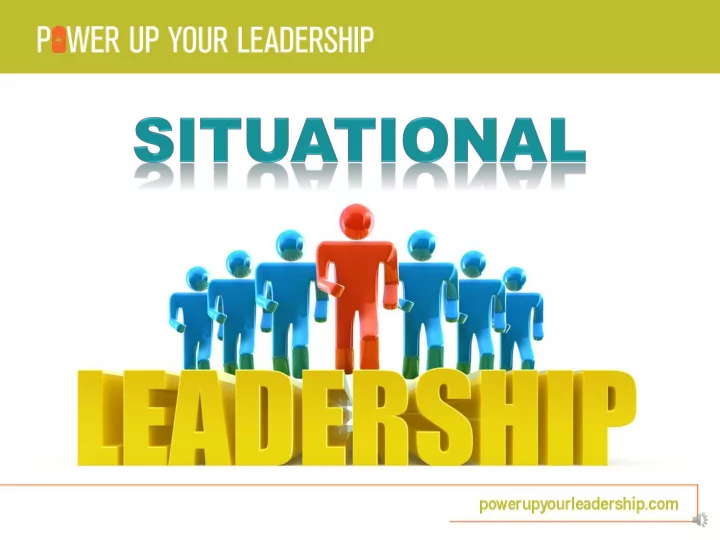

Directive & Supportive Behavior
Directive/Task Behavior Involves: Clearly telling people ▪ What to Do ▪ How to Do It ▪ Where to Do It ▪ When to Do It And then closely supervising their performance
Directive/Task Behavior On a scale of 1-10, how comfortable are you with Directive Behavior ? 1-- I don’t like it and don’t do it 5 -- Sometimes I do it 10 –It’s my go -to approach.
Supportive/Relationship Behavior Involves: Listening to people Providing support and encouraging their efforts Facilitating their involvement in Problem solving and decision making
Supportive/Relationship Behavior How comfortable are you using Supportive/Relationship Behavior? 1. Never; they don’t need my support 5. Sometimes when needed 10. I am always supportive; its my go-to approach
Situational Leadership Model
Diagnostic Questions: • 1. What is the specific goal/task? • 2. How strong are their demonstrated skills/knowledge for that task? • 3. How motivated, interested and enthusiastic are they? • 4. How confident and self-assured are they? • 5. What additional factors might also be affecting their performance? 8
Subordinate’s Development Level • Competence: Task, Knowledge and Skills • Commitment: Motivation and Confidence 9
Levels of Development • D1 Enthusiastic Beginner ▪ D2 D2 Disillusioned Learner ▪ D3 D3 Reluctant Contributor ▪ D4 D4 Peak Performer 15
Levels of Development ▪ D1 D1 Low Competence, High Commitment Enthusiastic Beginner
18
Directing High directive, low supportive Leader defines roles of followers Problem solving and decision making initiated by the leader One-way communication 19
Levels of Development ▪ D2 D2 Some Competence, Low Commitment Disillusioned Learner
20 DEVELOPMENT LEVEL OF FOLLOWER(S)
Coaching High directive, high supportive Leader now attempts to hear followers suggestions, ideas, and opinions Two-way communication Control over decision making remains with the leader 21
Levels of Development ▪ D3 D3 Moderate to High Competence, Variable Commitment Reluctant Contributor Capable but Cautious
22
Supporting High supportive, low directive Focus of control shifts to follower Leader actively listens 23
Levels of Development ▪ D4 D4 High Competence, High Commitment Peak Performer
24
Delegating Low supportive, low directive Leader discusses problems with followers Seeks joint agreement on problem definitions Decision making is handled by the subordinate They “run their own show” 25
Levels of Development ▪ D1 D1 Low Competence, High Commitment Enthusiastic Beginner ▪ D2 D2 Some Competence, Low Commitment Disillusioned Learner ▪ D3 D3 Moderate-High Competence, High Commitment Reluctant Contributor- capable, cautious ▪ D4 D4 High Competence, High Commitment Peak Performer- self reliant achiever 15
Development Level is Task Specific!
26
What happens if we have a mismatch of leadership style with development level?
The Leader’s Goal Build your follower’s development level so you can start using less time-consuming styles (S3 and S4) and still get high quality results.
Increasing Follower Development Level Tell them what you want them to do Show them what you want them to do Let them try − there is some risk Observe performance − focus on the positive Manage the consequences
Situational Leadership is not something you do “ TO TO ” people but something you do “ WITH WITH ” people.
Home Play Suggestions for moving forward: Share your preferred style and ask for feedback: • Where do I match? • Where do over -supervise? • Where do I under -supervise? Set goals for each person you supervise via 2-way conversation Schedule 1:1s to monitor performance and provide feedback
Recommend
More recommend